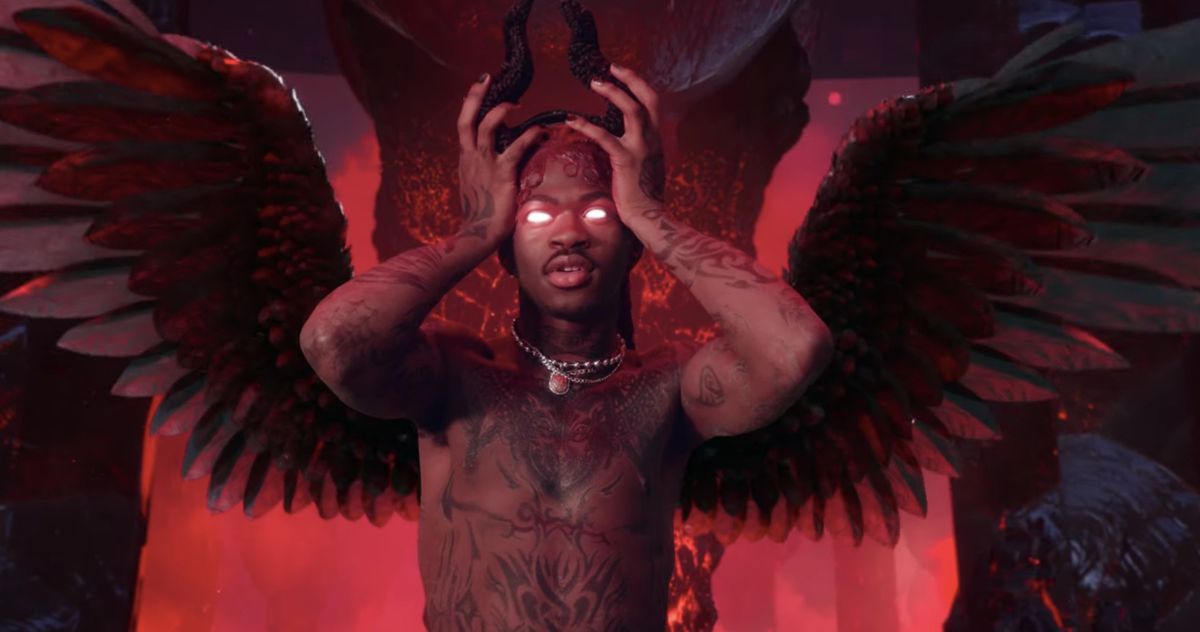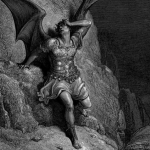I
“The reason Milton wrote in fetters when he wrote of Angels and God, and at liberty when of Devils and Hell, is because he was a true poet, and of the Devil’s party without knowing it.” (William Blake, The Marriage of Heaven and Hell)
Recently, the rapper Lil Nas X has stirred up some controversy with his video “MONTERO (Call Me By Your Name)”. The song is a celebration of the singer’s queerness and is, as the kids say, a bop. With lyrics about oral sex and evocations of the Eden myth, the song would surely have been controversial anyway—but what really sent heads flying into the stratosphere was the accompanying video which, if you’ve not seen it, you should really just go check it out right now.
Based on the reaction from the United States, or at least from the US internet (which is, I am assured, the same thing), one would think that Satanic imagery was something fresh and shocking and that identifying with the devil was utterly unheard of. Of course, that’s nonsense; like most symbols, the devil has meant different things to different people at different times. Even within connected religious traditions, the importance of the devil has varied; in the book of Job he seems to be more or less a legal figure, while he barely shows his face in the New Testament; for the most part, he haunts the fringes of the narrative like a roaring lion but does not assume a starring role until the Revelation.
In the history of Christian art, Old Scratch has gone through a few different incarnations. In medieval depictions he is generally some sort of rough beast—memorably, in Dante, chomping on betrayers in an icy lair. Another notable appearance is in the Codex Gigas, where he is green-faced, goggle-eyed, and nude save for a loincloth:
This was the devil who haunted the Western imagination for much of Christian history. Then, somewhere around the Enlightenment, something changed. Satan got hot. Where before he was a mildewed ear, the Prince of Darkness transmuted into something closer to a dashing hero—or, at least, a dashingly tragic antihero:
The culture was never the same. Neither was art. Blame Paradise Lost. Whether Milton intended his Satan to be the real hero of the epic has been historically debated—my understanding (and I am not a Miltonist) is that currently scholars believe that he very much did not. Milton being safely dead by the time the Romantics came along, his intention matters very little for the narrative I am sketching. To the Romantics, Satan was the hero (or tragic antihero) of Paradise Lost precisely because he stood up to a brutal authoritarian dictator and took his lumps when they were administered. One does not easily recover from the noble anguish of this Romantic Satan. In the book Romantic Satanism: Myth and the Historical Moment in Blake, Shelley, and Byron, author Peter A. Schock offers one suggestion as to why this transformation took place:
The diverse forms of Satanism in English Romantic writing arose out of a set of cultural acts and forces converging in the historical moment: anti-Christian or ‘infidel’ polemics and histories of religious myth, political and propagandistic uses of the figure of Satan, and the widespread fascination with Milton’s sublime archangel, propelled by the revisionist criticism and illustration of Paradise Lost.
That is to say—Satan got hot for political reasons. Schock points out that literally calling opponents devils was part of the standard rhetorical bag of tricks at the time. In response, some political actors (mostly those on the side of revolutionary change) assumed the title of Satanic and decided to wear it proudly. For Schock, this political response is reinforced by the Romantic reading of Milton’s Satan, especially as he appears in the early parts of Paradise Lost, and that fascination became a central part of Western iconography.
Satan was linked to Prometheus—or, at least, drawn into a similar web of concerns. Prometheus, you will remember, stole fire from the gods and gave it to humans, thus earning condemnation and wrath from Zeus, who chained him to the side of a mountain and allowed birds to pick at his intestines. Like Prometheus, Satan defied divinity and, like Prometheus, he was punished— and these are two qualities of Romantic heroes. The Romantic individual asserts his individuality in transgression against the gods (the Powers that Be, often hostile to sexual or political deviation). Subsequently, the Romantic individual is often punished. Nevertheless, the nobility of the individual against the Powers that Be is asserted even in that individual’s downfall.
After the Romantics there was never a way back; we are all, even the most ostensibly anti-Romantic, Romantics at heart. And so this new sexy Satan became a recurring figure in art, from Romanticism to symbolism to Rock n’ Roll:
Just as every cop is a criminal
And all the sinners saints
As heads is tails
Just call me Lucifer
‘Cause I’m in need of some restraint
So if you meet me
Have some courtesy
Have some sympathy, and some taste
Use all your well-learned politnesse
Or I’ll lay your soul to waste, mm yeah(The Rolling Stones, “Sympathy for the Devil”)
None of this is unambivalent, mind. As Schock points out, Blake’s conception of the devil shifts over the course of his career, and he and Byron et alia were never quite so wholeheartedly Satanist as they were Promethean. This ambivalence itself is part of the whole package; the magnetism of the Lord of Darkness is precisely that he is, we know, evil—and that evil is in some ways irresistible.
II
The mind is its own place, and in it self
Can make a Heav’n of Hell, a Hell of Heav’n. (John Milton, Paradise Lost)
I should probably make some things clear here. First, my discussion of “Satanism” is not intended to encompass the contemporary movements grouped under “Satanism” (for an example of one of these, see the documentary Hail Satan?). I am not myself a Satanist, nor am I an expert on the movement; neither am I claiming that Lil Nas X is himself a religious Satanist. Rather, I want to make some observations about the aesthetic use of occult or Satanic imagery, since it is here that (I think) most of the confusion and discussion seems to cluster.
“MONTERO (Call Me By Your Name)” opens with a voiceover as the camera zooms through a multicolored landscape: “In life, we hide the parts of ourselves we don’t want the world to see. We lock them away. We tell them no. We banish them. But here we don’t. Welcome to Montero.” This word, Montero—the title of the song, the name of the mythical landscape, is also Lil Nas X’s birth name. The camera comes to rest on the singer himself, dressed in a kind of bodysuit that might almost suggest nude flesh, playing a guitar while a snake (also Lil Nas X) curls around a tree. This is obvious Eden imagery. Then we see Lil Nas X on trial in a Louis XIV-influenced Mount Olympus; we see him ascending toward heaven, welcomed by a faceless angel. And all of this is pretty tame, visually; suspicious minds might worry about the quotation from Plato that blazes briefly on the Tree of Life, but the quotation itself seems to be a fairly mild quote from The Symposium, in which one of Socrates’ houseguests offers a myth for the origins romantic couples. But then a stripper pole rises from below and the rapper grabs it and begins swinging and dancing downward, his hair red now, clad only in boots and Calvin Klein underwear while he sings the principal refrain of the song. He touches down outside the gates of an immense city, surrounded by a fiery moat. Reader, it is hell. And there, seated on a throne (surrounded by a pentagram with a Latin phrase that seems to translate to something like “They condemn what they do not understand”) is the Prince of Darkness himself, Satan. Lil Nas X proceeds to give this individual a lapdance before breaking the monarch’s neck and assuming his horns (and presumably the governorship of hell).
In addition to all this, Lil Nas X commissioned a run of 666 specially made sneakers known as “Satan shoes” with a drop of human blood in the ink and a reference to Christ’s claim to have seen “Satan fall like lightning.” I think it should be fairly clear that there is a lot going on in both the video and the merchandising. After all, the shoes are at least in part about the fall and defeat of Satan, just as the video is at least in part about giving the devil a lapdance and then killing him. But these are subtleties too minute for the Mrs. Grundies of the American Republic, and outrage was inevitable.
The usual suspects weighed in. I will not run through all of them; if you are curious, you can go to Lil Nas X’s Twitter page, where he spent the week following the video’s release merrily dunking on anyone foolhardy enough to attempt to tangle with the newly-crowned king of hell. These accusations ranged from bewailing the fate of the rapper’s soul to condemning him as the cause of the woes of Black people everywhere. It may seem harsh to take a charming and good-spirited 21-year-old and to saddle him with the struggles of an entire community, but Lil Nas X’s critics are largely from the party of personal responsibility, and so it makes sense that they hold Lil Nas X personally responsible for everything they hate. The most common complaints seem to be that the rapper is representative of the degradation of society from our noble Judeo-Christian traditions into a degenerate hellscape in which lissome young lads gyrate against leather-clad muscledaddy demons. I hope the genealogy I sketched in part one at least partly addresses this peculiarly ahistorical assertion.
Naturally, supporters have come out in force, with arguments ranging from the dreariest tu quoque allegations to detailed explanations of the video’s appeal to queer youth. We can dispose of the former set of examples handily. Coming as I do from a mostly-conservative background, I can assure my more liberal readers that, yes, the same people who don’t like Lil Nas X’s dance moves were frothingly (ahem) upset with Cardi B. and Megan Thee Stallion. There are differences in inflection, which I will touch on below, but for the most part the Grundies are consistent in hating open sexuality in music, no matter the content unless the song is “Cat Scratch Fever,” as former Arkansas Governor Mike Huckabee has demonstrated.
The second set of defenses is much stronger. There is undeniably something wonderful and unique about seeing a queer Black man writhing in queer ecstasy in a music video. Queerness in music is not always sexless, but the past decade has certainly shown that, for want of a better term, it goes down better with the other-sexers if same-sexers keep the “sex” part fairly muted. I can only imagine how queer youth of today must feel to see such a prominent artist foregrounding his own sexuality and sexual desires in such a forthright way.
However—you knew there would be one, right?—there is a curious ahistoricity to all this appreciation, just as there is to the criticism. Except for a few voices pointing to the history of pop and rock music (Madonna! Little Richard!), very few people seem to be interested in situating Lil Nas X within a broader tradition. Indeed, some observers seem to be under the impression that he is sui generis. In fact, there is a whole curiously wrought patchwork behind the rapper that I would like to examine, albeit briefly, in this essay.
III
What are the roots that clutch, what branches grow
Out of this stony rubbish? Son of man,
You cannot say, or guess, for you know only
A heap of broken images, where the sun beats,
And the dead tree gives no shelter, the cricket no relief,
And the dry stone no sound of water. (T.S. Eliot, “The Waste Land”)
In his book The Birth of Modernism, Leon Surette questions traditional understandings of Modernism as skeptical, rational, and relativist. He suggests that the Modernists—and Ezra Pound in particular—were fascinated by the occult, with its allegations of secret societies and histories passed from generation to generation. This sort of occult knowledge promises that the elite—those who are “in the know,” who are “with it,” can trace the hidden forces of history (gnostic, druidic, atlantean, promethean, masonic…) and so can understand that “hidden wisdom” that has been concealed.
One prominent example of a Modernist dipping into the occult is, paradoxically, the future arch-Christian T.S. Eliot, who in “The Waste Land” makes extensive use of Jessie Weston’s From Ritual to Romance, a book that is—as Surette informs us—fundamentally occult and theosophical. Weston claims to discover in the stories of the Holy Grail a whole lost history of fertility rites, ruthlessly suppressed by Christianity and yet still existing in Arthurian legend. This mythology is recognizable as the forebear of Holy Blood, Holy Grail and its attenuated successor The Da Vinci Code—tales that purport to discover occult gnostic wisdom hidden in plain sight within Christianity’s mythology.
The fascination with occult history and secret societies is not limited to the Modernists. Many of the religious movements of the early-twentieth century—including some that were predominantly observed in African American communities—were (and, insofar as any of them still exist, still are) essentially occult in nature. They purported to discover or reveal a secret history in which (for instance) eugenic race theories were upended, so that people of African descent were more highly evolved than people of European descent (an interesting look at this belief-system can be found in The Autobiography of Malcolm X). In his book Mumbo Jumbo, Ishmael Reed offers an entire (and entirely fictional) occult history of religion as a struggle between hoodoo and the “atonists”—that is, people who worship only one god or only one ideology. Christianity, as the arch-atonist religion, is enemy number one. If any of this interests you, I encourage you to seek out Reed’s “NeoHooDoo Manifesto,” which suggests an occluded or occult history of art and literature that is fundamentally centered on the Black experience. Reed turns the world upside down, seeks to show the hidden history of the oppressed as the true history of culture.
When a member of an oppressed group inverts an order of oppression, that person is making a point—that person is taking the only power left to them in an oppressive society, the power of being downtrodden. It is essentially the same thing as the command to “turn the other cheek….” Inversion is a powerful tool for reclaiming some sort of authority over one’s own situation. It is frightening to the powerful because it is an outright rejection of the idea that the person should be abject or ashamed. It takes the final thing left to it and converts it into a symbol of power. This is what the reclamation of slurs does (to take another example)—for a person of a racial or sexual minority to take an insult and wear it as a badge of honor robs the slur of its power, converts that power, directs it another way. Hester Prynne’s scarlet letter becomes her strength.
IV
“What do you know about…voodoo?” (Jane Jensen, Gabriel Knight)
Another tradition that runs along similar lines (at least, to an outsider like myself) is voodoo. Voodoo is a kind of punchline for much of contemporary media (as in the Monkey Island games or their offspring the Pirates of the Caribbean series), unless it’s a menace (think Gabriel Knight: Sins of the Fathers). Now, voodoo is not Satanism, but within the popular white imagination it reads as Satanism. The opacity of its rites, the ecstasy of the person ridden by the loa—these are portrayed in mass culture as foreign, alien, and threatening. Not for nothing is voodoo often allied with the powers of darkness in popular entertainment—Jane Jensen was more correct, perhaps, than she knew in blaming it for slave rebellions, because the energies that drive voodoo and the energies that drive the quest for freedom are in fact the same. In some degree, at least to my inexpert understanding, voodoo is the practice of being wrong-footed. Pushed back into an impossible situation, the practitioner seizes hold of that precise impossibility and transforms it into power.
A big part of the mystery surrounding it has to do with how uncommunicable voodoo actually is. In an article for The Southern Literary Journal, Brenda Marie Osbey cautions readers in her title not to expect clarification: “Why We Can’t Talk to You about Voodoo.” Voodoo, and the voodoo experience, is not something that can be communicated. However, the movement seen in voodoo—wresting control from the powerful and transferring it to the powerless—is plain to see. As D. Soyini Madison observes in “Oedipus Rex at Eve’s Bayou,” voodoo operates on the principle that, when all that is left for one to do is die, only death can give power. The victim of social oppression enacts power by insisting too fully on the distinction made by the oppressors. “You say all I can do is die?” they say. “Very well, I will assume the power of death.”
The weakness becomes strength.
V
The neighbors said that this rich garment belonged to the Black Man’s wardrobe, and that he kept it at Mother Rigby’s cottage for the convenience of slipping it on whenever he wished to make a grand appearance at the governor’s table. To match the coat there was a velvet waistcoat of very ample size, and formerly embroidered with foliage that had been as brightly golden as the maple leaves in October, but which had now quite vanished out of the substance of the velvet. (Nathaniel Hawthorne, “Feathertop: A Moralized Legend”)
The Puritans believed that the forest surrounding them was the residence of a figure they called the Black Man, ostensibly Satan, who with his Satanic Indian hordes lay in wait to entrap the unwary Puritan. In “Young Goodman Brown,” the titular young goodman goes to meet the devil in the woods one bright day, leaving behind his wife Faith and seeking out the forbidden pleasures of the Black Mass; his object is precisely this same Black Man and his native hordes.
What draws Brown to this communion? And what is he feeling as he travels and realizes that everyone he knows or has known—including ultimately his beloved Faith—is part of the Satanic order? We know that it does Brown no good, for his dying hour (so says Hawthorne) is gloom—but that repulsion does not exist for readers, who are more likely to side with Hawthorne’s besotted admirer Herman Melville, who exclaimed “At all events, perhaps no writer has ever wielded this terrific thought with greater terror than this same harmless Hawthorne.”
It was under the influence of Hawthorne that Melville produced his greatest work, Moby-Dick, with its towering, Satanic central figure of Ahab. Ahab, when he makes his appearance and announces his decision to chase down and kill the whale who maimed him, is confronted by his first mate, a man named Starbuck. Starbuck suggests that such vengeance is blasphemous, prompting from Ahab the clearest statement of Promethean ambition that can be hoped for from an American novel:
All visible objects, man, are but as pasteboard masks. But in each event—in the living act, the undoubted deed—there, some unknown but still reasoning thing puts forth the mouldings of its features from behind the unreasoning mask. If man will strike, strike through the mask! How can the prisoner reach outside except by thrusting through the wall? To me, the white whale is that wall, shoved near to me. Sometimes I think there’s naught beyond. But ’tis enough. He tasks me; he heaps me; I see in him outrageous strength, with an inscrutable malice sinewing it. That inscrutable thing is chiefly what I hate; and be the white whale agent, or be the white whale principal, I will wreak that hate upon him. Talk not to me of blasphemy, man; I’d strike the sun if it insulted me. For could the sun do that, then could I do the other; since there is ever a sort of fair play herein, jealousy presiding over all creations. But not my master, man, is even that fair play. Who’s over me? Truth hath no confines.
This is the Romantic American protagonist in all of his Satanic-Promethean glory, and if Ahab is mad (he is) and if he is doomed (he is) and if he is responsible for the destruction of his ship and crew (he undoubtedly is), he is also grand and overpowering. Like Milton’s Satan, and like Hawthorne’s, we cannot help but be attracted.
Permit me to suggest that the mixture of emotions we feel when we confront Lil Nas X grinding on Satan is not so different from the mixture we feel when confronted with the towering, Satanic Ahab—or the Promethean Miltonic Satan—both desire and repulsion, admiration and distrust. Nor are the rapper’s religious critics safe from this ambiguous desire. I am not the first person, nor will I be the last, to draw comparisons between “MONTERO” and the late evangelical celebrity Carman’s “Satan: Bite the Dust” (or his equally lurid “The Witch’s Invitation”). Carman’s fantasy involves cowboys and gunshots, but the delight in grotesquerie that pervades his music videos is no less perverse than Lil Nas X’s enthused gyrations, not to mention the already-fetishistic quality of the cowboy mythos, a mythos Lil Nas X has already exploited. Carman berates the devil and shoots him; Lil Nas X makes love to the devil and then kills him. Both enact an erotically-charged dance, putting them in a direct tradition that encompasses Ahab, Gatsby, Ellison’s Invisible Man—all rebels both successful and unsuccessful who dared to strike through the mask.
VI
Ayy, can I pop shit? (pop, pop)
I might bottom on the low, but I top shit (but I top shit) (Lil Nas X, “Holiday”)
 This eroticism that pervades both evangelical depictions of Satan and Lil Nas X’s suggests another element to the hysteria surrounding the music video, one that the tu quoque I outlined above tries to get at but fails. Satanic imagery is not new. Metal bands and rock groups have dabbled in it for years, have even sold things that look an awful lot like Lil Nas X’s ballyhooed “Satan shoes.” Lil Nas X is a model of his generation in his ability to troll the olds and convince governors to make a fool of themselves by bickering with a pop star on Twitter, but the particular Satanic ground he is breaking is not actually all that new.
This eroticism that pervades both evangelical depictions of Satan and Lil Nas X’s suggests another element to the hysteria surrounding the music video, one that the tu quoque I outlined above tries to get at but fails. Satanic imagery is not new. Metal bands and rock groups have dabbled in it for years, have even sold things that look an awful lot like Lil Nas X’s ballyhooed “Satan shoes.” Lil Nas X is a model of his generation in his ability to troll the olds and convince governors to make a fool of themselves by bickering with a pop star on Twitter, but the particular Satanic ground he is breaking is not actually all that new.
What is new is that he is a gay Black man doing it, and more than that he is a gay Black man who is enthusiastically and unapologetically receptive (there is nothing submissive about his performance…). Carman, a butch Italian, demonstrates his manliness by insulting and then shooting Satan (in the name of God, sure, but the erotic charge of his machismo is anything but holy). Lil Nas X, in contrast, obstinately refuses to be butch. Surely I am not the only person who, on the third or fourth watch-through of the video, amidst the furor and clamor, was reminded of Leo Bersani and his discussion of “the infinitely more seductive and intolerable image of a grown man, legs high in the air, unable to refuse the suicidal ecstasy of being a woman” (Leo Bersani, “Is the Rectum a Grave?”). I will let others unpack this, but it seems to me that the real obscenity here (and I mean obscenity here in that it is what really makes people angry) is not the Satanic imagery but the vision of a gay Black man performing a desire that isn’t painfully butch—one that is, we might even say, flaming? The accusation of effeminacy is one with which gay pop stars have had to deal for a while, but as long as they keep sexuality safely muted (on the DL, we might say), audiences have been perfectly happy to allow them to exist as entertainingly bizarre sideshows. The embrace of effeminacy has long been a way in which gay pop stars deal with this audience demand—again, think of Satan, Prometheus, Hester Prynne, all figures who take the condemnation leveled at them and make it a source of power. What Lil Nas X does (and it is unusual for a rapper of his prominence) is foreground the sexual subtext that accompanies accusations of effeminacy. He makes bottoming a point of pride.
I am not going to turn this into a disquisition of queer culture, but I hope it should be clear that the threads I’ve touched on—voodoo, Romantic Satanism, and so on—all have a certain thing in common, and that is that they are all in one way or another appropriations of oppressive imagery. Among the issues confronting us in this video are the way that Black men have been demonized in American literature and history and the way in which gay sexuality plays into various expectations of gender and race. Lil Nas X seems to be taking an old, old path here. You say my only power is to die? Very well (says the practitioner of voodoo), I will seize the power of death and use that power. You say I am Satanic in my will to assert my own political or spiritual self? Very well—I will take your imagery, take your Satan, and will use him to assert my power. You say I am a degenerate, a pervert? Well, la-di-da, I will take all of that and throw a parade outside your door. Not because I am demonic, or because I even believe in Satan, or because in any real sense I am perverted—but because when you have been pushed so far that only insults remain yours, you take those insults and use them.
This is something like magic, though one would hesitate to assign it any metaphysical or even real political power–though the overblown reaction of certain individuals on the Grundier side of the spectrum would suggest that they, at least, do assign it political power. Many have noted how Lil Nas X’s inversion, perversion, and revision of Satanic imagery is a response to how queer kids are themselves demonized and rejected. This is certainly true. But what I’m wanting to get at is that Lil Nas X is part of a tradition, and it’s one that encompasses a history that precedes Madonna—precedes Little Richard, even. There is an enormous body of work explaining what he’s doing and why he’s doing it. None of this is shocking, though (I insist!) it’s very very good. What is, perhaps, more shocking is that anyone is shocked by it at all. Perhaps that very shock attests to the still-vital power of the transgressive move.










